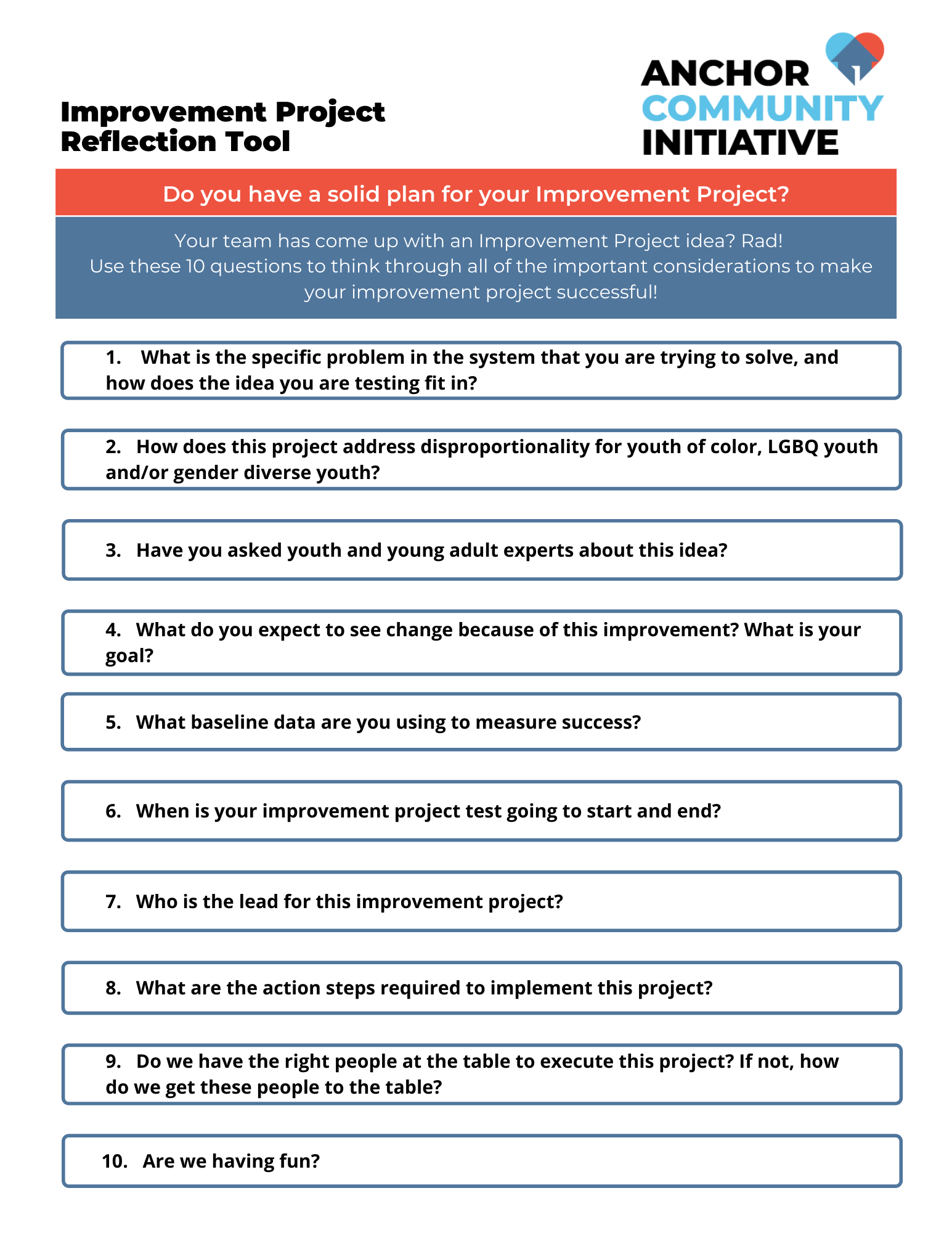What is an improvement project?
An improvement project is a time-limited test of change to a system. We call improvement projects a “PDSA” (Plan, Do Study, Act). Project parameters increase the likelihood of success and keep you from getting stuck. Each project plan must be specific, actionable, and measurable.
What are the components of an improvement project?
Project Lead: One person should be responsible for this project’s success. They will design the project with the Team Lead, plan data collection with the Data Lead, assemble a work team if needed, manage implementation and testing, and regularly report back to the Team Lead as the project unfolds.
Start and End Dates: Give your project a defined length in order to measure its progress, as well as to create a decision point about whether to expand, tweak, or stop it. Time-delimited improvement projects also create capacity for team members to trade off with other responsibilities on a temporary basis.
A Measure: Measuring the result of a change is the only way to know if a change resulted in an improvement. Don’t worry about picking one that is complicated or elaborate; simply identify something to count that will give you just enough information to know if the change is working as you intended.
Predicted impact toward reaching Functional Zero: You will know if it is a “test” and not just a “task” if you are making a prediction – “if we try ___, we expect ___ result. Get clear on the ultimate value you expect to achieve with this improvement project. Do you want it to make lasting reductions in your monthly inflow? Speed up your monthly outflow? If you cannot make a compelling prediction, take this project back to the drawing board.
How do we select an improvement project?
Consider your current data, needs, and assets. With the full landscape in view, make a theory about what needs to change about your system in order for you to reach functional zero. Break down that change into a small action that can be tested quickly, without extensive permission or funding. Note that an improvement project should work on a part of your system, not a one-time event such as hiring or creating a committee.
More important than finding the right idea is implementing your idea in the right way.
What is ideal timing for improvement projects?
We expect that our typical community team will run 2-3 projects at a time which may include a number of smaller tests of change or PDSA cycles. When one project ends, begin another. Projects may last anywhere from a couple of weeks to a few months. Design them to be as short as possible so that you can test your change idea quickly, tweak or scale it, then move onto the next idea.
Click through for a downloadable version
My improvement project ended. What do we do now?
Study the results and then decide: Do we adopt, adjust or abandon. If the project fulfilled your prediction, then work with your team to adopt and scale the change and make it permanent. If it fell short of expectations, then study what happened and alter your theory. You may either adjust the current project to test a new angle or you may abandon this project as one that did not get the kind of impact you were hoping for. Start the next project: Wherever you find yourself now, figure out the next change needed to get to functional zero, and launch a new improvement project. It may relate to the project that just ended or may go in a new direction. You may reuse the Project Lead or give a new person the opportunity to lead work. More important than finding the right idea is implementing your idea in the right way.
How is an improvement project different than work planning we did previously?
The fixed time period stops changes from dragging on forever. We advise you to run no more than three at a time, whereas previously we saw communities try to tackle 10 or 12 change ideas at once and complete few. Balancing your portfolio of improvement projects requires you to consider your team’s capacity, priorities, and ambition level. Finally, the attention to measure each project’s results should yield more tangible results; if you don’t expect to see tangible results from an improvement project, then reconsider that project’s urgency.

